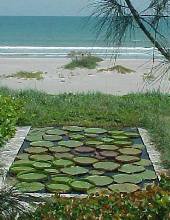Trust
by Kit & Ben Knotts - Click images to enlarge
 Reflection August 11, 2004 |
 September 8, 2004 |
 November 22, 2004 |
What began as another record year in our adventure with Victoria was redefined by forces of nature almost beyond our comprehension. When we wrote the paragraph below, we never could have imagined what was in store for us.
|
From our Preview of 2004, written in May -- We got brave and installed several of our plants in Reflection the end of February, weeks earlier than we have ever attempted it before. They were plants that were successfully over-wintered in small pots in a barely heated duneside tank. (Our experiences with over-wintering is one of the articles in this year's chronicle.) By mid-April, we had installed all five plants in Reflection for the season, 'Adventure' (center of the left image above), two amazonicas and two cruzianas. Now, in May, the plants are growing well and we have a big head start over previous years. Nine more that we will grow to adulthood and two Euryales are either installed in other ponds or growing up in propagation tanks. Most of our on-purpose germination work for the year is done and we have seen some surprising results. Our adventure continues with -- Survivor Paradise |
 In
mid-August Hurricane Charley brushed us with his outer edges,
damaging the Victorias pretty badly. In early September Hurricane
Francis hammered us for two days and absolutely buried the garden
in sand. This was something we never dreamed would happen. Having
the beach washed away, maybe even seawall damage, perhaps storm
surge in the duneside ponds
In
mid-August Hurricane Charley brushed us with his outer edges,
damaging the Victorias pretty badly. In early September Hurricane
Francis hammered us for two days and absolutely buried the garden
in sand. This was something we never dreamed would happen. Having
the beach washed away, maybe even seawall damage, perhaps storm
surge in the duneside ponds  all
were possibilities -- not a sandstorm of, for us, epic proportions.
Surreal is the only word to describe the scene. In spite of being
buried in sand, the Victorias struggled to survive. Obviously
they could not.
all
were possibilities -- not a sandstorm of, for us, epic proportions.
Surreal is the only word to describe the scene. In spite of being
buried in sand, the Victorias struggled to survive. Obviously
they could not.
Three weeks later, Hurricane Jeanne slammed us, adding more sand to the garden and, this time, severely damaging the house. For pages about the storms, see Hurricanes 2004.
Now we come to trust and, more importantly, how it saved our year. Several cruzianas started to bud in early May. Since they were still rather small and we have believed plants stop increasing in size when they begin to bloom, we cut the buds off. In late May, when an amazonica wanted to bloom (they often wait until August), we reconsidered the advisability of continuing to cut off the buds. We became convinced the plants "knew" something we didn't.
There is an old wives' tale that sea turtles lay their eggs high up in the dunes when hurricanes are imminent and lower on the beach when they are not. The "behavior" of our Victorias made us feel a little eerie and we began to predict and prepare for serious tropical weather. By trusting our plants, almost the entire 2004 seed crop was collected before Hurricane Frances struck.
Interestingly, this year the plants did continue to increase in size after they were blooming. Nine Victorias and two Euryales grew to adulthood and seed production. The early start of blooming allowed nearly as many flowers as in normal years. A plan for selfing and crossing based on some sort of disaster produced seeds for all species and hybrids in reasonable numbers. Yield per pod was higher than in previous years, though typically late season pods (we had no late season) are smaller and might have reduced the average.
Friends, many of them members of our email discussion list, came to help us dig out, some individually and some for Dig & Drag I and II. In digging out Reflection, several tagged pods were recovered. They had remained wet and should be viable. More pods were found as we excavated Dune.
 Dig & Drag I Gallery |
 Sean |
 Dig & Drag II Gallery |
 Alan |
All the younger plants, installed and in propagation ponds, were buried and died, with two notable exceptions. Though partially buried in sand and debris twice, a wild Argentinian cruziana and a wild Paraguayan cruziana have struggled to survive. Now we just need to bring them through the winter to have a start for next year.
There WILL be next year. We have grown most of our Victorias in the duneside ponds because of better light. Those ponds, of course, were and are buried the deepest. Until we actually saw Reflection filling with water, there was no assurance that Victorias would have a home in the spring of 2005. Thanks to wonderful friends, they will.